 Royal Navy (built 1940-47)
Royal Navy (built 1940-47)Iroquois, Athabaskan, Huron, Haida, Micmac, Nootka, Cayuga, Athabaskan (II)
Canada Day ! The Canadian Navy had its largest extension in its history during the second world war. When it ended, the RCAN was the world’s fourth largest in tonnage and number of ships. This Navy operated cruisers, destroyers and plenty of Frigates, taking a critical role in the Battle of the Atlantic, front and center. It was also a time when Canadian shipyards maintained and repaired a lot of British and Canadian vessels, battered and worn out after the punishing conditions of north Atlantic crossings. But it was also the start of them taking part in the allied shipbuilding effort. HMCS Athabaskan, Haida, Huron, Iroquois, Cayuga, Micmac and Nootka thus became the first major warships built in canada. These heavy destroyers were seen as the best thing next to a cruiser, and compared to all previous destroyers operated by the RCAN, they were much larger and better armed, with a 30% more engine power.
Some authors call them the “Canadian Tribals”, or “Athabaskan”, or “Iroquois” class, but to avoid the confusion to the ones built in the cold war, they are simply assimilated to the Tribal class at large. We will mostly concentrate on their career here. For extra technical details, see the British Tribals article.
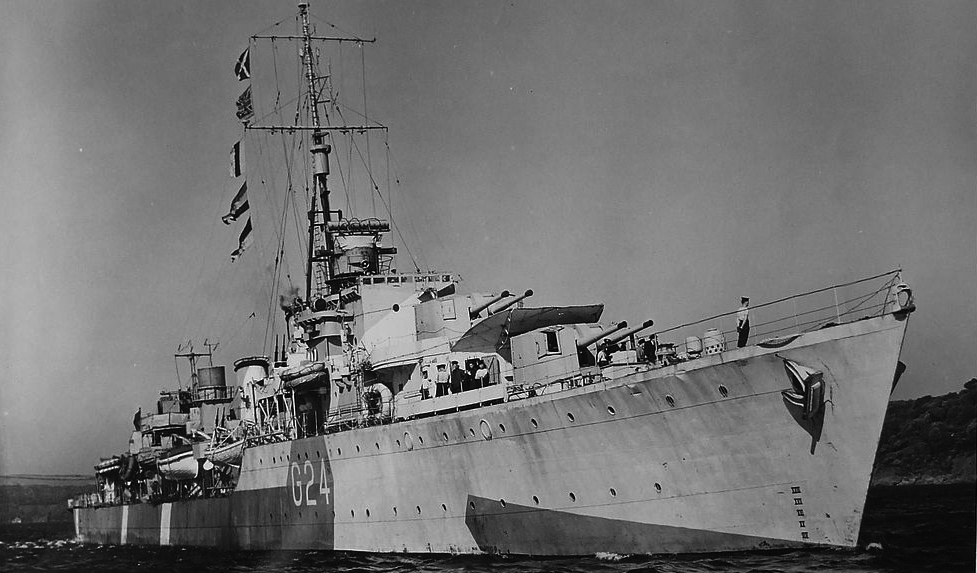
The biggest difference for the Tribals was their armament, which was nominally a large increase in firepower, sacrificing one torpedo tubes bank. The usual provision was four twin 102 mm guns and two quadruple 40mm pompoms. Variants saw an increase of AA artillery and the sacrifice of one turret. Twin turrets was also highly unusual at that point, but the ‘Tribals’ which production started before the war in 1937, went in the Empire, plans being sent to Australia and Canada to built their own ships. *Australia built the Arunta, Bataan, Warramunga at Cockatoo.
twin turret 102 mm To the exception of Athabaskan (II), Cayuga, Micmac, Nootka which had four twin 102/45 QF Mk XIX guns, the others were armed with three turrets armed with the 120/45 QF Mk XII and one with the 102/45 QF Mk XVI. AA provision was one or two quad 40 mm Bofors, and twenty 20 mm Oerlikon guns.
Design of the Canadian Tribals
Development
The Canadian Tribals was derived from the Brtiish ones, which developement way all the way back to 1926 with the prototypes HMS Amazon and Ambuscade defining a new standard design, later followed by the A-B and up to the I class. The latter introduced a new type of bridge, but otherwise, the whole interwar lineage was a copy-paste with gradual iterations. But the RN had a problem from 1935. All these “interwar standard” destroyers, excellent for the 1920s and largely exported, or built abroad under licence, were now dangerously exposed to the latest advanced made in the future axis. The Japanese “special type” for a start, the German Type 1934 and follow-up and the Italian Navigatori class, were all superior on paper. So, to counteract this new trend in 1935, the Admiralty embarked on a completely new destroyer design with an emphasis on firepower over torpedoes.
‘Design V’ was a start, an earlier (1933) design study for a small fleet cruiser in what later became the Dido-class AA cruiser. The initial design was very small cruiser at just 1,850-ton standard, 36.25 knots endurance of 5,500 nautical miles and no less than five twin 4.7 inch guns as main armament. It was rejected and by August 1935, it was exhumed, compared to eight other design proposals and chosen by the admiralty later this year then refined as an eight 4.7 inch Quick Firing Mark XII guns. The latter mount was capable of 40° and were controlled by a low-angle (LA) director and high-angle/low-angle (HA/LA) rangefinder director.
These could thus performed AA and A/S roles as a good complement to Dido class. They were also to integrated the new Fuse Keeping Clock High Angle Fire Control Computer.
Still, the admiralty wanted and obtained a quadruple bank of torpedo tubes. The hull had a new slightly sloped stem, almost clipper bow, and overall had a well-balanced design with two raked funnels, superfiring guns fore and aft. They truly were handsome ships with a long forecastle for excellent sea keeping.
They were started in 1936 and construction completed in 1939-41. In all, the RN obtained 16 destroyers from a collection of naval yards.
At the start of WW2, the Canadians were consulted over doing their share to the effort of defending the Empire. It was agreed to a program of construction, maintenance and repairs for both RN and RCAN ships, and building brand new vessels as well. This led to agreements to buil in Canada under licence a flurry of ships, notably Flower-class corvettes and later the River class frigates. Like in Britain, they were simple enough to be built in civilian, or mixed skills shipyards. However, Canada also wanted destroyers to be built locally and negociations in early 1940 led to the licencing of the Tribal class design, which impressed the Canadian Admiralty. However after consultation, the only yard that could build sizeable warhips, Halifax shipyards, was not modern and well equipped enough.
So it was decided to procure to Canada (paid by Canadian taxpayers) a first batch of four destroyers that could be available quickly, at Vickers Armstrongs, Newcastle. That was the maximal capacity than can bre freed for Canada. These were the HCMS Athabaskan (later Iroquois), Athabaskan (I), Huron and Haida.
It was agreed than Halifax NyD would be ramped up to have the capacity and measn to built such modern destroyers as required. This led to the second batch, called by some the Micmac sub-class. However given Halifax’s lack of experience, construction, started in May 1942 for the frst two, and Ocerober 1943 for the third, May 1944 for the last one, dragged on. The shipyard only had two dockyards large enough indeed, so the forst two needed to be launched to free space for the next to be laid down. There were also delivery shortages from Britain. As a result, none saw combat in WW2: Micmac was completed in September 1945, almost two weeks after the official end of the war, Nootka in 1946 Cauuga and Athabaskan in 1947. This was ten years after the launch of the first Tribal. For the Australian Tribals, started earlir at Cockatoo, they were delivered all before the end of the war, in fact Arunta and Warramunga were commissioned in 1942 and saw a lot of action. The British-built Canadian Tribals were completed in 1942-43 and also saw a lot of action.
Construction in Canada
Civil political issues
The selection of Halifax Shipyard for the first Canadian-made Tribals was done by the Minister of Defence for Naval Services, Angus L. Macdonald. A Nova Scotia native and former province Premier, he returned to the post postwar and until 1954. The choice was pushed for political interest, as the four ships represented a mass of jobs and opportunities as well as quite a boost for the Halifax shipyards in capabilities, skills and experience. But it remained a challenge nonetheless: Even with all requisite materials and facilities available, there were still scores of difficulties to vanquish. Canada had stil few specialied suppliers for such enterprises in 1941. The most experienced at the time, was the Vickers yards in Montreal. The choice of a smaller and less equipped shipyard in Halifax for the Canadian Tribal program seemed at the time a risky, odd choice.
In 1939 Halifax Shipyard in Nova Scotia, was distant from major industrial centres of Canada for once, isolated on a colder northern coast. The city had a modest population and even more modest industrial capacity, so few skilled workers to go with. From 1940 until the end of the war between these awaited technical facilities and lack of skilled labour force available was added the strain of having the best workforce already having its hands full on repair and refit of damaged ships coming back from many Atlantic convoys from Bedford Basin. The activity there was intense and until 1945, the city remained one of the busiest and most congested ports in the world, already working at full capacity for the needs of the convoys’s damaged ships, civilian and military.
Even Vickers Montreal, in fact no shipyard in Canada at the time, ever constructed a ship as complex as these modern and powerful destroyers. Halifax’s limited experience even by Canadian standards was poor indeed, with just four large freighters late in WWI and an advanced icebreaker in the interwar. HMCS Micmac, the first to be laid down, was in one of the only two suitable drydocks, at yard number. She was hull No. 12, indicating just how few ships the yard had constructed.
MacDonald knew all this, and managed to silence his detractors, by a bunch or aguments: First off, Halifax Shipyards produced some advanced and successful vessels. Two of its 1920 refrigerated freighters such as the SS Canadian Cruiser and SS Canadian Constructor, very large by Canadian standards, remained the largest Canadian steel ships built until then. The icebreaker CGS N.B. McLean was a solid, long-serving ship and one of the world’s largest icebreakers. Halifax also had the advantage of nearby naval staff at the RCN’s Halifax Naval Dockyard in the south.
And the construction of destroyer could retain and concentrate all the workforce necesssary not only already to repair and maintain, but also built these destroyers, housing this precious, skilled workforce and helping sustaining the port’s repair capacity, also training more skilled personal. Previously indeed, demand for skilled shipyard works soared in the winter, but however fell off in the summer and workers, jobless, started to leave in 1939. So the destroyer program, when announced, managed to retain them for many years of certain work, with the same available workforce able to be switched around from repair to new ship construction. The big counter-argument was that this would slow down destroyer construction, but that was brushed over. Both MacDonald and the RCN naval staff were in accordance on this.
A long-term vision for the RCN
The yard selection was indeed confirmed by the Royal Canadian Navy Chief of the Naval Staff, Admiral P.W. Nelles, influenced by these institutional considerations for the future of the RCN.
Many in the staff had been aware of the precarious status of the RCN, progressively reduced in strength until by 1922. To the point its very survival as an independent service was in jeopardy especially after the 1929 crisis, where some even throught of having it disbanded altogether for a coastal patrol force in the style of the US coast guard, a naval branch of the Canadian mounted police.
This experience influenced many members of the Naval Staff that in 1939, were determined to forestall any possible re-occurrence at the end of the Second World War, and for this, what better than Canadian-built warships, that would need to be care for in Canada as well and quickstart later project. The experience on the long run proved beneficial indeed. If the Halifax built destroyers were delivered after the war ended, it nevertheless was seen as a major achievement for Halifax and for Canadian naval construction at learge. It paved the way for generation of cold war escort destroyer with a unique and proper Canadian design.
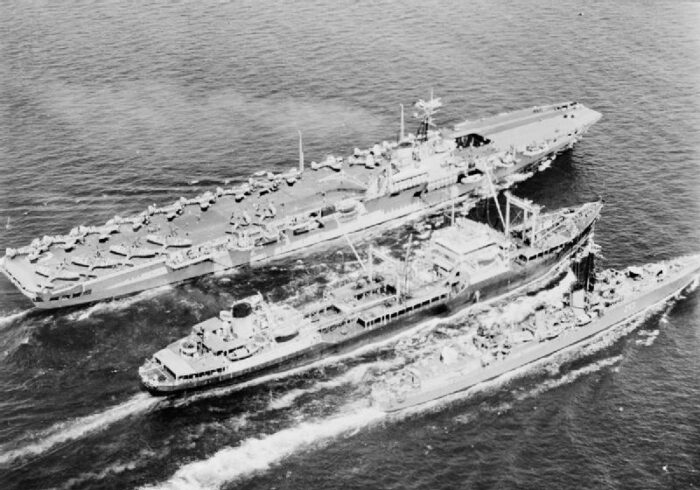
The Tribals class became the centerpiece of the escort force for two Canadian Aicraft Carriers, notably HCMS Magnificient (here) during deployments in Korea. All seven Tribals made from two to four tours of Duty off Korea, west and east coasts. Post-WW2 all 5 served in Halifax and two on the west coast at Esquimalt for a time. In 1960 they were all seven back on the east coast, close to skilled labor at Halifax for numerous repairs and fixes.
Admiral P.W. Nelles wanted to employ these wartime funding opportunities to establish the post-war RCN as a major and permanent, part of Canada’s defence strategy. So he and his staff wee hard at work for obtaining the necessary infrastructure to support this new upcoming fleet and setup the technical know-how in the vicinity Halifax, making it the center of the RCN. So in the end, despite the construction time making them missing the war of all wars, with a contemporary view, it really enabled the RCN the means to exist in the cold war, becoming an important founding member of NATO and remaining so until today.
Naming
Being “tribals”, the Canadian destroyers needed to be named after Canada’s first nations:
Athabaskan: Also called Alaskan Athapascans or Dena, Native and original inhabitants of the interior of Alaska.
Iroquois: Part of the 5 and later 6 nations of the North West, originally called the Haudenosaunee.
Huron: Huron-Wendat First Nation, also Wyandot, Great Lakes/Michigan peoples.
Haida: One of the nations of the Pacific Northwest Coast of North America.
Micmac: After the Mi’kmaq people of the Maritime provinces, Nova Scotia and Newfoundland but formely established all along the Northeastern Woodlands down to Maine and Quebec.
Nootka: (Nuu-chah-nulth) Canada’s Pacific North-Northwest Nation.
Cayuga: Border (Canad/US) frontier Iroquois Confederacy People.
Yards:
Vickers Armstrong, Newcastle: Athabaskan*, Cayuga, Micmac, Nootka.
Halifax shipyards, Canada: Micmax, Nootka, Cayuga, Athabaskan (ii)
*She was sunk in action in April 1944 by German T24.
The Canadian order initially was for four ships from British yards in 1940 and they were indeed completed in 1942 and 1943, but the other four were also to be built from Canadian yards, at Halifax, starting in 1942 but not completed until after the war. From 1937 and 1945, no less than twenty-seven Tribals were built, the largest destroyer class since WWI, with an estimated cost per ship of around £340,000, excluding weaponry, £520,000 overall. To compare, an H-class, classic destroyer, cost £278,482 without equipments. That was a hard pill to swallow. But the “value” of these new destroyers was seen as twice as much in value compared to a classic G-H-I class vessel.
Hull and general design
The British Tribals were a bit larger, but still nearly identical to the British ones at 1,959 long tons (1,990 t) tons standard and 2,519 long tons (2,559 t) deep load versus 1,854 long tons (1,884 t) standard and 2,520 long tons (2,560 t) deep load. The Canadian Tribals built in Halifax were ever larger at 1,927 long tons (1,958 t) standard and 2,745 long tons (2,789 t) full load. From 1850 to 1930 tonnes that was quite a gap, of 80 tonnes to be exact. They benefited from all the improvements made on the wartime Tribals before completion and were substantially modified, notably having the fiercest AA armament and best sensors of the Tribals when completed
To compare, the previous I class displaced 1,370 long tons (1,390 t) standard, 1,888 long tons (1,918 t) deep load…

Inboard profile, HCMS Haida 1940 (greenwich coll.)
In terms of dimensions they were very close. The first batch (Vickers ships) measured 377 ft (115 m) overall for 37.5 ft (11.4 m) in beam and a draught 11.2 ft (3.4 m). The late Halifax built Tribals, are better known dimensions: They measured 355 ft 5 in (108.33 m) between perpendiculars, 366 ft 6 in (111.71 m) at the waterline and 377 ft (114.91 m) overall, which most authors rounded up to 115 m using metric. In beam that was the same at 37 ft 5 in (11.40 m) but in draught it was 9 ft (2.74 m) (standard) and 13 ft (3.96 m) at full load, more precised measures adn slightly deeper draught overall due to the extra 80 tonnes of equipments.
They did not used aluminium for the superstructure but thin soft steel plating like the originals. Due to the danger of fire. Like the original Tribals also they had low mounted fuel tanks with a seawater filling compensation system. The hull was built with extra compartmentation plus double bottom, lower ammunition magazines but a constrained metacentric height.
The bridge kept the same shape as the original. All the remainder is identical to the regular Tribals, so we will concentrate on the armament.
Powerplant
To power these ships, there were two Parsons geared steam turbines, each driving a shaft, and 3-leaf fixed pitch propellers. Stema was provided by three Admiralty 3-drum boilers for a combined output of 44,000 shp (33,000 kW). The Tribals were capable of 36 knots (67 km/h; 41 mph) at full battle load with an oil capacity ranging from 505 to 516 tonnes for a range of 5,700 nmi (10,600 km; 6,600 mi) at 15 knots (28 km/h; 17 mph). Being heavier, the 1945-47 Canadian Tribals were probably a knot slower at 35 knots in top speed.
Armament
BL 4.7 inches/45 Mark XII
Specifications Mark XII
Mass: 3.238 – 3.245 tons (3,290 – 3,297 kg)
Length: 224.08 in (5.692 m), Bore 212.6 in (5.400 m)
Shell: HE/SAP 50 lbs. (22.68 kg), 15 in (38 cm) long
Cartridge: Brass 4.724 x 30.922 in (120 x 785.42 mm)
Charge: 11.58 lbs. (5.25 kg) SC 109 or 13.13 lbs. (5.96 kg) NF/S 164-048
Full round with charge: 30.5 lbs. (13.8 kg) with propellant
Perfs CPXIX Mounting:2,650 fps (808 mps), RA 40° 17,000 yards (15,545 m), 10-12 rpm
Armour penetration wa 2.5″ (63 mm) of 90° stell armour from 6,500 yards (5,950 m) with the AP round.
4-inch (102 mm) twin HA Mark XIX mount/Mk XXI guns
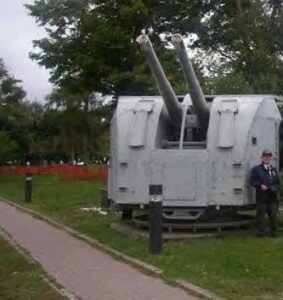 The 4-inch twin high-angle Mk XIX was proper to the Canadian Tribals. The british ones had one aft on the structure instead of “X” mount, but further inwards. It armed also the “Hunt” and “Weapon” classes, Canadian “Tribal” class destroyers, three “L” class destroyers and HMS Petard. They had an enveloping shield and needed a crew of 8 for a rate of fire of 15-20 rpm.
The 4-inch twin high-angle Mk XIX was proper to the Canadian Tribals. The british ones had one aft on the structure instead of “X” mount, but further inwards. It armed also the “Hunt” and “Weapon” classes, Canadian “Tribal” class destroyers, three “L” class destroyers and HMS Petard. They had an enveloping shield and needed a crew of 8 for a rate of fire of 15-20 rpm.
Specifications Mark XIX mount
Weight: Gun 3,397 lbs. (1,541 kg), total About 36,000 lbs. (16,333 kg)
Elevation/Range -10 / +80 degrees, AA range 39,000 feet (11,890 m), surface (45°) 19,850 yards (18,150 m)
Shell: HE: 63.5 lbs. (28.8 kg), SAP: 66.75 lbs. (30.28 kg). MV 2,000 fps (610 mps) to 2,660 fps (811 mps)*
*Depending on charge.
40mm/39 2pdr QF Mk VIII
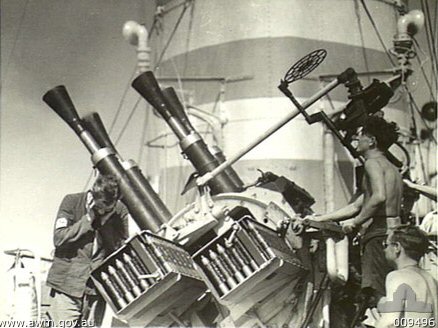
Specifications pompom Mark VII
Calibre: 40 mm L/39
Shell Weight: 2 lb. (980 g) or 1.8 lb. (820 g) for High-Velocity (HV) round
Rate of Fire: 115 rpm fully automatic
Effective Range: 3,800 yards (3,475 m) or 5,000 yards (4,572 m) HV
Effective Ceiling (HV): 13,300 feet (3,960 m)
Muzzle Velocity: 2,040 ft/s (622 m/s) or 2400 ft/s (732 m/s) for HV
21-inches torpedo tubes
The greater change made by the previous G-H-I was to go from triple (A-B, C-D), to quadruple (E-F class) quintuple torpedo tubes banks. The same types were installed on the Tribal class, a single mount which was reloadable thanks to cranes. The torpedo models depicted below are the ones most likely to be assigned:
Mark IX** (1935)
This standard model was designed from 1928, first appeared in 1930, and was considerably improved by 1939. Its best speed was 41 knots but at 35 knots, less than a Tribal at full speed.
Weight: 3,732 lbs. (1,693 kg). Neg. buoy. 732 lbs. (332 kg)
Length: 23 ft 10.5 in (7.277 m)
Explosive Charge: 805 lbs. (365 kg) Torpex
Range and Speed settings: 11,000 yards (10,050 m)/41 kts, 15,000 yards (13,700 m)/35 kts
Power: Burner-cycle, 264 hp @ 41 knots
The Mark X was introduced in late 1940 and perhaps installed, it was capable of 47 knots thanks to a wet-heater.
Mark XI(1944)
“A British electric torpedo developed from 1942 and introduced from 1944. It was an attempt to copy the german G8e-T2 (captured) as a trackless topedo for submarines in the Mediterranean. None was delivered before the war ended, when the Tribals were scheduled to join the BPF, so they were never deployed but postwar for trials. More
Specs:
Weight 3,632 lbs. (1,647 kg), lenght 22 ft 5 in (6.833 m)
Negative Buoyancy: 734 lbs. (333 kg)
Explosive Charge; 710 lbs. (322 kg) TNT
Range and Speed, unique setting, 5,500 yards (5,000 m) at 28 knots, powered by Electric batteries.
Depth Charges
Mark VII depth charge thrower being reloaded.
See the British Tribals for more.
Mines
Mark XIV mines:
These were a 1920s design with either 320 lbs. (145 kg) or 500 lbs. (227 kg) charge, and Hertz horns. Switch horns were installed and they became the Mark XVII.
Sensors
Sonars
Type 124: From 1937, improved Type 121, range 2500 yards, 1st with chemical range recorder.
Type 144: From 1943, range 2500 yards (2300 meters) to 3000 yards (2700 meters), integrated into the fire control and coupled with Hedgehog. 1st with bearing recorder, automatic scanning, turning 5 degrees after each ping, often coupled with the Type 147 “Sword” depth finding sonar with a beam steerable vertically. Also coupled with the Q attachment reducing the under hull blind spot. 60° deep vertical beam, trained with the main Type 144 transducer.
When purchased by Canada, the four C-class destroyers were refitted on Canadian specifications and saw the Type 124 ASDIC installed, and steam heating probably fitted.
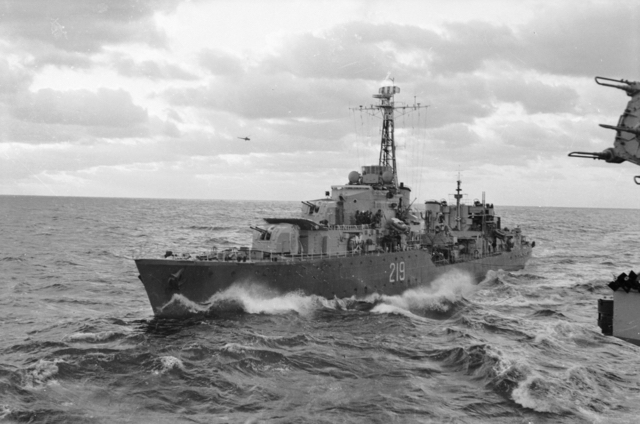
HMCS Athabaskan in 1951 (AWM)
Fire Control
Fuze Keeping Clock High Angle Fire Control Computer.
The Fuze Keeping Clock (FKC) was a simplified version of the High Angle Control System analogue fire control computer. The first model for destroyers was the FKC Mk.II in destroyers of the Tribal class. It was a non-tachymetric anti-aircraft fire control computer, capable of engaging targets at up to 250 knots (460 km/h; 290 mph).
It received vertical reference information from a Gyro Level Corrector, giving the aircraft’s altitude, range, direction, speed from the Rangefinder-Director. The guns received in turn on an indicator, their own correct elevation and deflection data relative to their position on the ship, and correct fuse timing to explode as close to the target as possible. A similar system was developed in the US for the 5-in/38 which later swapped only a more effective magnetic-proximity fuse. The Tribals had their Fuse Setting Pedestals or Fuse Setting Trays set on a clockwork mechanism within the AA shell warhead itself.
On the Canadian Tribals, it was coupled with the Type 285 radar.
Radars
Athabaskan (I) was completed with the type 271, type 272, type 285, type 291 radars and type 144 sonar typical of other Tribals.
Huron and Haida omitted the type 272.
Micmac and Nootka however were completed with the type 268, type 275, type 277, type 282 and type 291 radars and same sonar as above.
Cayuga and Athabascan (II), the last two, had a type 262 radar as only charge, the rest was identical.
Type 286:
Naval air search radar, first destroyer set, very crude, not rotating. Full data 286P: rotating antenna, better bearing accuracy of 3-5 degrees.
This was a metric target indication set, based upon RAF ASV Mark II set. The Type 286M had fixed antennas (central Tx and sides Rx) to indicate contact bearing. Fixed antenna so the entire ship needed to be aimed in the right scanning angle. The Type 286PQ had a steerable combined Tx/Rx antenna from the Type 291 set at least.
Type 271:
Small surface search radar using a standard microwave-frequency system with improved resolution to spot surfaced U-boat 3 miles (4.8 km) around, or a periscope at 900 yards (820 m). Full data
Type 285:
Anti-aircraft gunnery radar available from late 1940, Frq 600 MHz, power 25 kw, range 18,000 yd (16,000 m), ceiling 15,000 ft (4,600 m) accuracy 150 yd (140 m).
Type 144 Sonar:
Complement Informations on the Tribal class
Wartime Modifications
Cayuga and Athabaskan as completed had four twin 4 in DP guns, a twin and four single 40 mm (1.6 in) AA guns, the same usual quadruple 21 in torpedo tubes as well as a single rack, and two throwers for DCs. Iroquoi ended the war with her triple main turrets QF Mk XII, twin 4-in/45 QF Mk XVI, quad 40mm/39 2pdr QF Mk VIII pompom, six 20mm/70 Oerlikon Mk II/IV, quad 533mm TT, 2 DCT, 1 DCR (30 DC). Athabaskan (I) differed for her four twin 20mm/70 Oerlikon Mk II/IV, and two single 20mm/70 Oerlikon Mk II/IV.
Huron and Haida were completed postwar with the same but six twin 20mm/70 Oerlikon Mk II/IV.
Athabaskan (II) and Cayuga only kept two 4-in/45 QF Mk XVI gun, complemented by a twin 40mm/56 Bofors Mk VIII/IX, two single 40mm/56 Bofors Mk III, two twin 20mm/70 Oerlikon Mk II/IV, a quad 21-in TT bank and two 2 DCT two 2 DCR with a total of 46 DC.
Micmac and Nootka as completed in 1947 had the same, but no ASW armament apparently.
Postwar Modifications
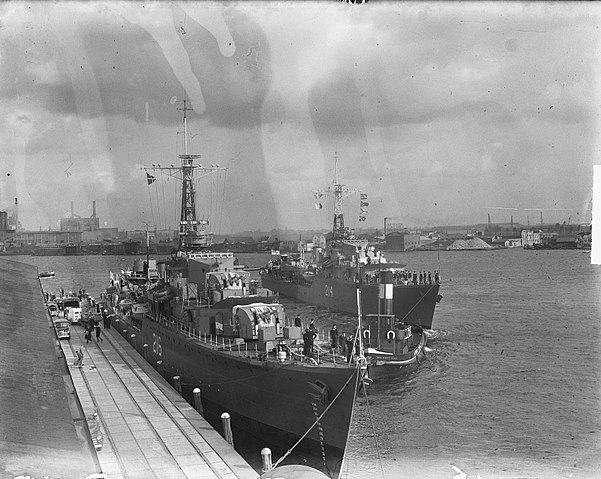
Huron and Micmac in Amsterdam, 1950
The “Tribals” were arguably the most powerful destroyer class built by the British during WW2, and they were also the best Canadian and Australian destroyers, built by local yards. Their main advantage was a powerful artillery in twin turrets, eight in all, to the expanse of a torpedo tubes bank. Canadian yards delivered eight vessels during the war, some completed in 1946: HMCS Haida, Cayuga, Huron, Micmac, Iroquois, Nootka and Athabaskan (ii), all bing named of Canadian Indian tribes. The 1st one, HMCS Athabaskan first of the name was sunk in action in 1944. Haida was one of the most active during the war and still preserved today. They formed the bedrock of classic surface warfare escort for the two Canadian cruisers in service and aircraft carriers in the 1950-60s, but were of course duly modernized to stay relevant in the 1960s.
Nootka, Micmac, Cayuga and Athabaskan were indeed even still fitting out when the war ended and saw service at the beginning of the cold war, incorporating many changes resulting from wartime lessons: Nootka and Micmac retained their 4.7 in guns but omitted their DCTs. They had 40 mm Pompom mounts aft instead and twin Mark V for Nootka on either side. Athabaskan had four twin 4-in /45 Mk 16 and a Mark 6 director and twin 40 mm Mk.V AA. Piecemeal modernization were staged in 1946 up to 1951. 4.7 in guns were replaced by 4-in, USN pattern Mk63 radars FCS, and Squid SW mortars on their quartedeck while all light AA was replaced by 40 mm AA Bofors.
In 1951 ful modernization began for the whole Haida class: It was staged in steps between 1952 and 1955 when the last was recommissioned. This was aimed at making them more ASW-capable according to the NATO policy of the time. It concerned the armament and fire control. Two Twin 4-in/45 Mark 16 UK pattern installed forward, a single twin 3-in/50 Mk22 aft on “X” position, four individual 40 mm/60 Boffins AA guns, and two Squid mortars on the quarterdeck. Short aluminium lattice fitted, new caps for funnels, Mark 6 or Mark 63 directors upgraded and stripped Mark III(W) director fitted for surface fire. They had also fiberglass shields for their 3-in guns (Cayuga and Athabaskan). As such, these vessels served the RCAN 1964-1969.
Specifications after 1955 refit:
-Displacement: 2200, 2500 tonnes FL
-Dimensions, Powerplant, Performances: same as ww2 Tribal class
-Armament: 2×2 4in/45, twin 3-in/50, 4x 40mm AA, quad 21-in TT, Squid ASWMR
-Electronics: Radar 275, SPS-10, SPS-6, 293, 262, Sonar 170, 174.
-Crew: 240
Appearance
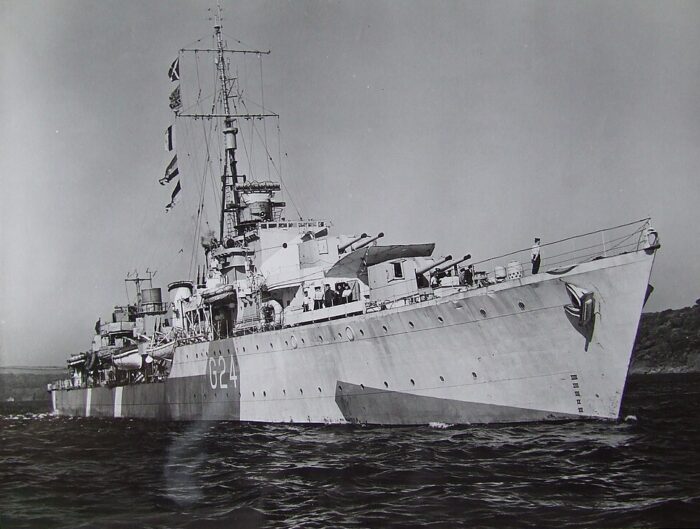
HMS Huron underway, note the straight lines camouflage made of light grey, light blue and dark grey, “western approaches”.
HD PROFILES AWAITED

Author’s old profile of HMCS Iroquois in 1944
To come…
⚙ Canadian (Halifax*) Tribal specs. |
|
| Displacement | 1960t standard, 2520t FL |
| Displacement* | 2200t standard, 2500t FL |
| Dimensions | Same as RN Tribals |
| Powerplant | Same as RN Tribals |
| Top speed | Same as RN Tribals |
| Range | Same as RN Tribals |
| Armament | 3×2 4.7 in, 4-in/45 AA, 1×4 2-pdr pompom, 6×20 mm AA, 1×4 21 in TTs, DCR, DCT |
| Armament* | 4×2 4.7 in, 1×4 2-pdr pompom, 2×4 0.5 in AA, 1×4 21 in TTs, 1× DCR, 2× TCT, 20 DCs |
| Armament (1955) | 2×2 102mm/45, 1×2 76mm/50 Mk 22, 4x 40mm/60 Boffin, 1×4 533mm TT, 2×3 305mm Squid Mk 3 ASWRL |
| Sensors 1945 | type 268, 271, 291 radars, Mk.III FCS+ Type 285 FCR, type 144/144Q, 147F sonar |
| Sensors 1955 | Radars Type 275, SPS-10, SPS-6, Type 293, Type 262, Sonar Type 170, 174 |
| Crew | c260 ww2, c240 1955 |
Tribal class Destroyers career
 HMCS Iroquois (1941)
HMCS Iroquois (1941)
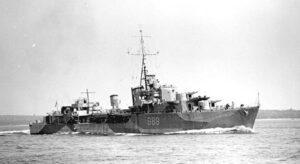 HMCS Iroquois was initially laid down as Athabaskan at Vickers Armstrongs, Newcastle on 19 September 1940 and launched on 23 September 1941. Due to bomb damage she and her sister had their names switched, to ensure Iroquois was commissioned first. It was on 10 December 1942 but she was only completed on 30 January 1943.
HMCS Iroquois was initially laid down as Athabaskan at Vickers Armstrongs, Newcastle on 19 September 1940 and launched on 23 September 1941. Due to bomb damage she and her sister had their names switched, to ensure Iroquois was commissioned first. It was on 10 December 1942 but she was only completed on 30 January 1943.
Following her completion she started her sea trials, after taking storm damage near the Faroes, and she needed keel and hull repairs. She still was on trials in the North Sea until May 1943 before heading for Plymouth. She started a career in calmer seas as convoy escort on Gibraltar convoys. On 11 July, her convoy was attacked by three Fw 200 Condors from Kampfgeschwader 40, west of Porto, Bay of Biscay. Iroquois was near-missed at 200 yards (180 m) astern. SS California and SS Duchess of York were hit and later abandoned, with Iroquois rescuing 628 survivors from Duchess of York. On 19 July there was a near-mutiny when a large section refused to perform their duties, leading later to an enquiry. She was deployed to cover escort forces in the Bay of Biscay from 12 June to 2 August 1943.
Back to UK for maintenance and R&R, Iroquois returned to escort convoys, this time the northern route, to the Soviet Union. On 1-11 October with Huron and Onslaught she sailed to Murmansk. In November she was in convoy JW 54A (from Loch Ewe, 18–24 November) and convoy RA 54B from Molotvsk (28 November). By late December, she escorted the convoy JW 55B, which came under air attack on 23 December. She was unscathed. The fake convoy was to lure out KMS Scharnhorst, later sunk in the battle of North Cape by Duke of York on 26 December. On new years’eve she escort the convoy RA 55B which from Kola Inlet to Loch Ewe (8 January) unscathed.
English Channel and the end of the war
By February 1944, she sailed to Halifax for a refit until early June (The northern route was not kind to the hull). Next she was assigned to the 10th Destroyer Flotilla for the Invasion of Normandy. After D-day, she patrolled the English Channel and Bay of Biscay. She took part in many operations like Operation Kinetic against French Atlantic ports and the Battle of Audierne Bay in August 1944. She fought a German force or ten ship by night with the Cruiser Mauritius and the Destroyer Ursa.
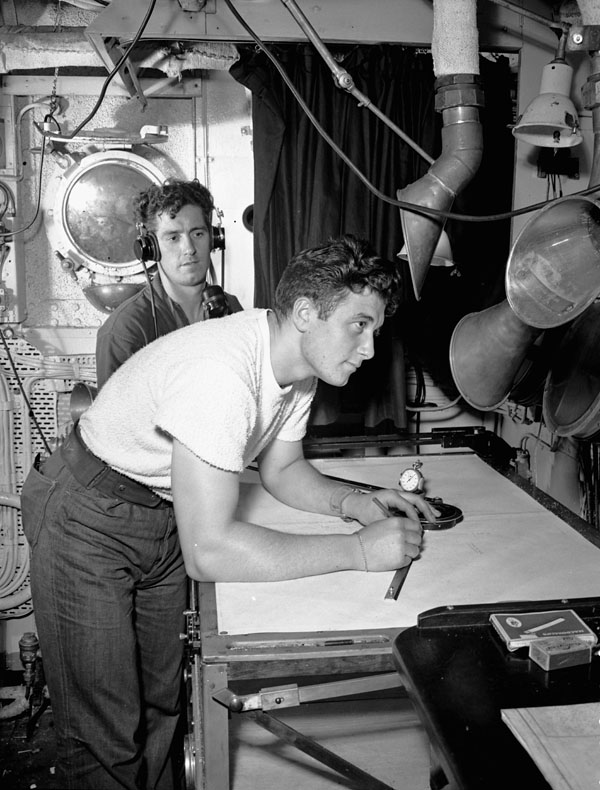
Radar plotters Able Seamen William Ewasiuk and Harry Henderson of HMCS Iroquois, 21 August 1944. One minesweeper was driven ashore and heavily damaged, a flak ship, five armed trawlers, and a Sperrbrecher. Iroquois fired 1,197 rounds and 231 star shells. Commandeur Davis reported the success deu to ULTRA and “the excellence of Iroquois’ radar and plotting teams”.
On 5 August 1944, she teamed wit the cruiser HMS Bellona and destroyers Tartar, Ashanti, and Haida. They engaged and sank the German minesweepers M 263 and M 486, patrol boat V 414, coastal launch Otto (Battle of Île d’Yeu). Iroquois alone sank two vessels. On 14 August she teamed again with Ursa and Mauritius to attack a German force off Les Sables d’Olonne. She sank Sperrbrecher 157, badly damaged M 275, ran M 385 aground. On 22–23 August with the same, she sank V 702, V 717, V 720, V 729 and V 730 of Audierne (second battle of Audierne). She patrolled the Bay of Biscay and Channel until October 1944 until sent to Scapa Flow, Home Fleet from March 1945.
She took part in the screening force for aircraft carriers on 19 and 24 March for air strikes along coastal Norway. She then escorted a convoy to the Soviet Union. On 16 April she escorted JW 66. On 29 April-2 May, she was in the last convoy battle with RA 66. Iroquois and Haida dodged a torpedo launch by U-427. In turn, she pursued and with other ships made a dropping of 678 depth charge but failed to sink the Type VIIC. She remained in the Jade and north sea under V-Day in Europe, and later carried Crown Prince Olav in exile back to Norway. In Copenhagen she escorted Prinz Eugen and Nürnberg for their formal surrender. Back to Canada she started a tropicalization refit for the Pacific, halted when Japan capitulated in August. She was paid off on 22 February 1946.
From 1947, she was converted as a destroyer escort, first in class and by 24 June 1949 was recommissioned as a training ship under command of Lieutenant Commander T. C. Pullen as DDE217.
On 21 October 1951, Commander Landymore took command. Her first and last cold war combat assignation was Korea under Landymore. She left Halifax on 21 April 1952 and relieved Cayuga on 12 June. She operated on the west coast, supported the Island campaign and on 2 October with USS Marsh she shelled a rail line SW of Songjin. She was hit by a field gun shell starboard close to ‘B’ gun with 2 men killed, 11 injured. She remained two weeks and sailed for maintenance-R&R at Sasebo. She later screened HMS Glory as part of the inshore patrol and sailed back home on 26 November when relieved by Athabaskan. She arrived at Halifax on 8 January 1953.
She made a second Korean TOD , departing on 29 April 1953 and from 18 June 1953, was in the Chodo area, Island campaign, west coast as well as in the Haeju area, aslo screening carriers off the west coast until hotilities ceased on 29 July. She was sent to evacuating islands handed back to North Korea and was in post-armistice patrol. On 1 November 1953 LtCdr S. G. Moore took command and she left Korea on 1 January 1954, to Halifax on 10 February via Suez and circumnavigating the globe. She later returned for more post-Armistice patrols, left on 1 July 1954 and arrived on 22 August and until 26 December, making another return via Suez on 19 March 1955 to Halifax. She was then demobilized and used as training ship until 1962. She was paid off at Halifax, 24 October 1962, laid up at Sydney, towed in 1966 for BU to Bilbao.
 HMCS Athabaskan (I) (G07, 1941)
HMCS Athabaskan (I) (G07, 1941)
 Athabaskan (I) was renamed from Iroquois. Names were swapped. She was also laid down at Vickers the same day on 31 October 1940, but launched later on 18 November 1941 and completed on 3 February 1943. She had a relatively short service of 14 months and experienced several major mishaps and battle damage so she was out of action for five months on this total, but maintenanace and other off-times made for not 11 but 9 months of active combat, 2/3 of a year.
Athabaskan (I) was renamed from Iroquois. Names were swapped. She was also laid down at Vickers the same day on 31 October 1940, but launched later on 18 November 1941 and completed on 3 February 1943. She had a relatively short service of 14 months and experienced several major mishaps and battle damage so she was out of action for five months on this total, but maintenanace and other off-times made for not 11 but 9 months of active combat, 2/3 of a year.
Work-up was short and she sailed on 29 March 1943 for the Iceland-Faeroes gap trying to stop blockade runners. Like her sisters this was short as heavy seas damaged her hull, followed by five weeks repair at South Shields. From June 1943 she was in Operation Gearbox III (relief of the garrison at Spitsbergen).
By 18 June she collided with the boom defence vessel Bargate at Scapa Flow (month repair, Devonport). In July-August she was in Plymouth for ASW patrols in the Bay of Biscay.
She was spotted and attacked, then heavily damaged by a Henschel Hs 293 glider bomb from a KG 100 aircraft bomber off Cape Ortegal, 27 August 1943. HMS Egret was sunk alongside her. The glider bomb passed entirely through her hull and detonated the other side, she was patched and survived, and had repairs at Scapa, departing by December 1943 to escort convoy JW55A to Murmacnsk and back in February 1944, Plymouth command, 10th Destroyer Flotilla for Operation Hostile (Minelaying) and Operation Tunnel (Patrol) off the coast of France. On 26 April, she assisted destroying T29 (Battle off Ushant) alongside Black Prince, Ashanti, Haida and Huron.
But on 29 April while patrolling with Haida in support, supporting minelayers off Morlaix River she was directed in interception of German warships near Ile de Bas, but in the engagement she was torpedoed and sank, with 128 lost, 44 rescued by Haida, and 83 taken as POWs by three German minesweepers later. Historians are conflicted as if it was due to shore-battery gunfire or one, or two torpedo. Official records tells of a second major explosion in the ammunition magazine due to a torpedo from T24 while under Cdr John Stubbs, KiA after declining rescue by Haida and returning to save other crew members on his ship before she sank. A plaque was erected on 2004 close to the site. Explored, the actual cause remained unknown. Haida was forced to depart quickly due to the threat of batteries and possible air attacks at dawn.
 HMCS Huron (G24, 1942)
HMCS Huron (G24, 1942)
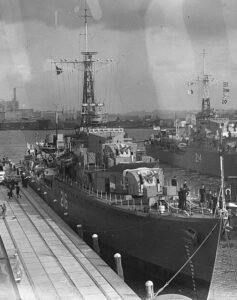 HMCS Huron was laid down at Vickers on 15 July 1941, launched on 25 June 1942 and completed on 28 July 1943. Assigned to the 3rd Destroyer Flotilla, Home Fleet on 1–11 October 1943 she escorted and carried special supplies and personnel to Murmansk (Operation Holder) bu while back she collided with an oiler, spending a month in repair at Leith. Next, she spend a year escorting convoys to the Soviet Union, six escort or “Murmansk Runs”: JW 54A (15 November), RA 54B (28 November), Convoy JW 55B (Ju 88 attack on 22 December) and was at the Battle of the North Cape on 26 December, witnessing the daring close quarter torpedo attack of HNoMS Stord.
HMCS Huron was laid down at Vickers on 15 July 1941, launched on 25 June 1942 and completed on 28 July 1943. Assigned to the 3rd Destroyer Flotilla, Home Fleet on 1–11 October 1943 she escorted and carried special supplies and personnel to Murmansk (Operation Holder) bu while back she collided with an oiler, spending a month in repair at Leith. Next, she spend a year escorting convoys to the Soviet Union, six escort or “Murmansk Runs”: JW 54A (15 November), RA 54B (28 November), Convoy JW 55B (Ju 88 attack on 22 December) and was at the Battle of the North Cape on 26 December, witnessing the daring close quarter torpedo attack of HNoMS Stord.
She escorted Convoy JW 56B (attacked on 25/26 January, 3 merchant lost, HMS Obdurate damaged). On February 1944, she was transferred to the 10th DF in Plymouth for operations along the French coast and Bay of Buscay in long preparations before D-Day. She took part in Operation Tunnel, Operation Hostile. In April 1944 she made 11 missions of mostly night-fighting, honing skills in radar-controlled gunnery and radar detection. On 25 April 1944 she clashed with the German 4th Torpedo Boat Flotilla. T29 sunk, other damaged, and herself was damaged when colliding with HMS Ashanti. She made more missions in May 1944 until reassigned to the Hurd Deep Patrol off Brest, Cherbourg or the Bay of Biscay. On D-day+1 she soprtied with HMCS Haida to relieve destroyers on patrol. On 9 June 1944 Ultra vectored them on German destroyers inbound for the Allied invasion fleet. This became the Battle of Ushant, off the coast of Brittany, a fierce gun battle. She assisted Haida badly damaged and running aground Z32. On 27-28 June with HMS Eskimo, she intercepted a detachment of minesweeper and trawlers, which detected them and tried to reach fellow coastal artillery. Huron sank a minesweeper and a trawler but the second severely damaged Eskimo. On 8 July 1944, Huron and Tartar attacked two German trawlers, but were driven off by coastal artillery. Later they preyed on the German 4th Minesweeping Flotilla off the Channel Islands on 7/8 July, sank the minesweepers M 4605 and M 4601. Next she was in Operation Kinetic, to intercept a German coastal supply on 31 July. She was back on 3 August and later made a final patrol and departed for Canada.
In August 1944, dhe started a refit at Halifax until November 1944, and returned to the Western Approaches in ASW patrols. In March 1945, she was in screening duties, Scapa Flow and the Clyde. On 16 April 1945 she made a final convoy to Murmansk and back at Scapa on 6 May 1945. She was part of the last convoy attack by U-boats of the war, seeing HMS Goodall sunk. With Haida and Berwick she departed Scapa for Trondheim and took over custody of surrendered U-boats back to Greenock on 24 April. By May she was back in Canada, statyed a tropicalization refit, cancelled in August. She was decommissioned, reserve on 9 March 1946.
Postwar as DD 216 she was a TS until sent for the Korean War from 22 January, arrived on 15 March 1951. In April with HMCS Athabaskan she screened aircraft carriers for airstrikes on Wonsan. In May she was on the west coast to screen carriers and for inshore patrols. She captured a large Chinese junk. In June she operated on the east coast also screening carriers and in shore bombardment, inshore patrols. Se escorted HMS Glory and USS Sicily in the “Han River Demonstration” as talks started in July. She departed on 14 August, arroved home on 21 September for a major refit until 1953. When back in Korea she was part of a Commonwealth Task Force from 18 June 1953 to 5 February 1954 in the Armistice time. Her third tour was between 1 October and 26 December 1954 wit the UN monitoring Korean waters. Back home she was a TS and took part in NATO exercises until paid off, reserve at Halifax from 20 April 1963, sold for BU at La Spezia, August 1965.
 HMCS Haida (1942)
HMCS Haida (1942)
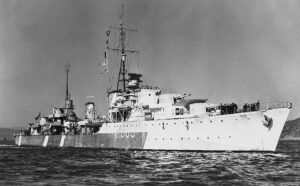 HMCS Haida was laid down at Vickers on 29 September 1941, launched on 25 August 1942 and completed on 18 September 1943 under command of H.G. DeWolf. She was assigned to the Home Fleet and on 15 November, escorted convoy JW 54A (18-24 November 1943). On 28 November this was RA 54B back to Loch Ewe on 9 December. Next convoy JW 55B on 20 December (Battle of the North Cape happened that time) but on the 23th the convoy was attacked by Ju 88 bombers, escaped unscathed. She joined RA 55B for the return journey from Kola Inlet on 31 December- January 1944. On 10 January she was assigned to the 10th Destroyer Flotilla at Plymouth for Operation Tunnel and Operation Hostile (see above). With Black Prince and Bellona she formed Force 26, perfoming 19 missions and the battle of 25/26 April, against the 4th TBF, sinking T29 and damaging T24, taking refuge in St. Malo. ON 28/29 April T24 and T27 attempted a sortie from St. Malo to Brest, but were caight by Athabaskan and Haida off St. Brieux. Athabaskan was torpedoed and sunk but Haida ran T27 agroun (later finished off by MTB 673). She rescued 44 survivors but had to leave the area. Later she teamed with Huron before Operation Overlord. On 8–9 June with TF 26 she was at the Battle of Ushant. She then covered Allied motor torpedo boat flotillas along the French coast.
HMCS Haida was laid down at Vickers on 29 September 1941, launched on 25 August 1942 and completed on 18 September 1943 under command of H.G. DeWolf. She was assigned to the Home Fleet and on 15 November, escorted convoy JW 54A (18-24 November 1943). On 28 November this was RA 54B back to Loch Ewe on 9 December. Next convoy JW 55B on 20 December (Battle of the North Cape happened that time) but on the 23th the convoy was attacked by Ju 88 bombers, escaped unscathed. She joined RA 55B for the return journey from Kola Inlet on 31 December- January 1944. On 10 January she was assigned to the 10th Destroyer Flotilla at Plymouth for Operation Tunnel and Operation Hostile (see above). With Black Prince and Bellona she formed Force 26, perfoming 19 missions and the battle of 25/26 April, against the 4th TBF, sinking T29 and damaging T24, taking refuge in St. Malo. ON 28/29 April T24 and T27 attempted a sortie from St. Malo to Brest, but were caight by Athabaskan and Haida off St. Brieux. Athabaskan was torpedoed and sunk but Haida ran T27 agroun (later finished off by MTB 673). She rescued 44 survivors but had to leave the area. Later she teamed with Huron before Operation Overlord. On 8–9 June with TF 26 she was at the Battle of Ushant. She then covered Allied motor torpedo boat flotillas along the French coast.
On 24 June she investigated a Liberator from 311 Sqn, dropping depth charges on a target. With Eskimo she dropped depth charge until the U-Boat surfaced but was gunned down (U-971). Haida rescued six survivors. On 14/15 July with ORP Błyskawica she intercepted German ships off Île de Groix, Lorient and sank the sub-chasers, UJ 1420 and UJ 1421, a merchant ship and badly damaged two more. On 5–6 August she was part of Operation Kinetic off Île de Yeu, caliling M 263 and M 486, V 414 and KMS Otto. She was hit one in a turret (2 killed, 8 injured), out of action. Next she was engaged by shore batteries when she tried to intercept a second convoy and withdrew.
On 22 September she left for Halifax and from 29 September started a refit and repairs. She was back to Scapa Flow in January 1945 and on 19 March escorted carriers in minelaying operations off Granesund and Trondheim (24-28 March). On 7 April she covered 7 ASW vessels from Greenock for the Soviet Navy to Vaenga, Kola Inlet. She escorted convoy JW 66 to the Clyde on 16 April. She escorted RA 66 from Vaenga (29 April-2 May), attacked in transit, dodging U-Boat attacks. missed. She was in Scapa on 6 May and sent for relief operations at Trondheimsfjord on 17 May. On 29- 31 May with Huron, Berwick and the 5th Escort Group she was sent to Trondheim to take over custody of U-boats. She departed for Halifax on 4 June for a refit for Operation Downfall, cancelled in August. Paid off on 20 March 1946, in reserve, she was refitted in 1947 as G63, complete by May 1947. With HMCS Nootka she was in exercises with the Atlantic Fleet and USN for years and entered the Hudson Bay late 1948. She escorted HMCS Magnificent in June 1949. In November she rescued 18 from a crashed B-29 in the Atlantic. She was later downgraded to a depot and accommodation ship in Halifax but reactivated for the Korean War from 25 June 1950, converted to a DDE from July to September 1951 and departed on the 27th for Sasebo, arrived on 6 November via Panama.
She relieved Nootka on 18 November. On 4 December she shelled a railway line with USS Moore in Songjin and silenced a NK coastal battery, and shelled North Korean troops on the open thanks to aerial recce. From January 1953 she escorted aircraft carriers and bombarded the coast. On 29 January she was in the “Trainbusters Club” by destroying a train north of Riwon and another on 26 May, and patrolled off Paengyang-do. She departed Sasebo on 12 June for Suez and Halifax on 22 July. She started a second TOD on 14 December 1953, arrived on 5 February 1954 and patrolled until 12 September, sailed back to Halifax via Suez. Next she was in ASW NATO duties on the North Atlantic-West Indies area. In May 1956 with Iroquois and Huron she made port visits in the Saint Lawrence River. By January 1958 she started a refit, still ongoing in 1959, before some service in the West Indies in January 1960 but still had a cascadeof failures, including her steering gear on 3 April. A survey found extensive corrosion and cracking so she was drydocked, repaired in June-July 1961 and after a sortie in heavy in March returned to correct more cracks and was in refit until February 1963. Eventually it was decided to decommission her. But eventually, instead of selling her for scrap, many Tribals veterans insisted for her preservation. She is now the last Tribal class destroyer in existence, restored in 1944 conditions near Toronto today, from 2003 as the HMCS Haida National Historic Site, Hamilton waterfront. Official site
 HMCS Micmac (1943)
HMCS Micmac (1943)
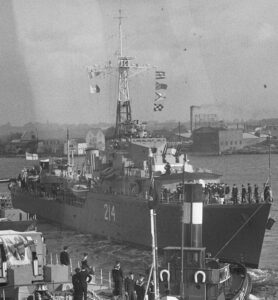 HMCS Micmac was the first laid down at Halifax Shipyards, on 20 May 1942, launched on 18 September 1943, and commissioned on 14 September 1945. The delayed arrival of the propulsion system from Inglis, Toronto, was a major issue explaining her late completion. Her first commander was Lieutenant Cdr R.L. Hennessy. She became the very first destroyer ever constructed in Canada at a cost of $8,500,000.00 CAD, 4 times it cost the RN to build a Tribal and single most expensive military equipment ever produced in Canada. However as the war had ended, she was risking to be paid off into reserve or to disposal. However Canada and Australia would find new uses for these late Tribal destroyers for the Cold War.
HMCS Micmac was the first laid down at Halifax Shipyards, on 20 May 1942, launched on 18 September 1943, and commissioned on 14 September 1945. The delayed arrival of the propulsion system from Inglis, Toronto, was a major issue explaining her late completion. Her first commander was Lieutenant Cdr R.L. Hennessy. She became the very first destroyer ever constructed in Canada at a cost of $8,500,000.00 CAD, 4 times it cost the RN to build a Tribal and single most expensive military equipment ever produced in Canada. However as the war had ended, she was risking to be paid off into reserve or to disposal. However Canada and Australia would find new uses for these late Tribal destroyers for the Cold War.
In March 1947, under LCdr. J. C. Littler, RCN, she was refitted for maintenance at HMC Dockyard Halifax, with upgrade her artillery. In the morning of 16 July 1947, she was at sea with civilian contractors for her full-power trials off Sambro Head. Before 13:00 hrs she collided with the Victory ship SS Yarmouth County (ex-Fort Astoria). Damage was slight on the latter, wit no men injured, but Micmac suffered 15 injured, five dead plus five crewmen and a civilian dock worker were lost at sea and presumed dead as well. All her upper works forward of the bridge was extensively damaged and “A” was destroyed. In fact she lost 40 feet of bow and all the port side was mushed, her keel broken under “B” mount. The collision was later blamed on navigational errors bu fingers were pointed at the wartime shipbuilding program. Micmac had to be drydocked again for reconstruction as destroyer escort with the other six surviving Tribals indeed, and had extensive and only temporary repairs with partial conversion. She was recommissioned on 16 November 1949 under LCdr. F. C. Frewer but her structural integrity was still compromised and she could not handle the recoil of the four HA guns planned for her DDE conversion so she was instead fitted with a single Squid Mk IV ASW mortar on “A” mount position, single 40mm Bofors on “B” mount with her 4.7″ guns removed and twin 4″/45 HA mount replaced in “Y” position.
Her DDE conversion started on 30 November 1951 Micmac as she was paid off to complete her conversion with her keel fully repaires, forward armament returned and she was recommissioned as DDE 214 on 14 August 1953 under Cdr. G. M. Wadds, working up until September 1954.
She was exclused for operations in the Korean War. As a result she was the only Canadian Tribal never to fire a shot in anger in her career. She spent her career as a training ship at someoccasions, as escort of HMCS Magnificent.
Micmac did not age well, her extremely light hull construction remained a problem and the consequences of her collission, never really fixed. Her transverse strength design and light hull plating, unsufficient longitudinal stability plus the damaged she received only made her far too flexible and weak in North Atlantic service, especially in winter. Her captans remembered this as a harrowing experience, hearing and creak and growl in the tall waves, to the point of being weary of a full breakage. The increased strength of high tensile steel plate was a provisional solution but it was not enough. Excessive hull flexure in heavy seas was in stark contrast to the cold war destroyer escort built in Canada in the 1950s, in complete contrast. Built like a rock, they were tailored to endure the icy north Atlantic winter. This made the Tribals, while impressive on paper, a less viable long term proposition and a hard sell for any modrrnization work.
MicMac like her sister had her fair share of hull cracks, feed water and fuel tank leaks, structural failures in general, turbine damage and despite several alterations with stiffener plates, as well as frames, stringers, braces or even new thicker turbine blade, she was to followe her four surviving sister before 1950 despite a short career. The growing cost of maintenance and demands on a restricted manpower conducted the RCN staff in 1963 to retire the Tribal class. Micmac was paid off in March 1964, sold in 1965 to Faslane shipbreakers in Scotland, already well experienced with BU other RN Tribals. Her bell was relocated on the mast of HMCS Acadia Sea Cadet training centre, Cornwallis Park training facility, Digby, Nova Scotia. Her name was reused by one of the new Canadian DDEs.
 HMCS Nootka (R96 1944)
HMCS Nootka (R96 1944)
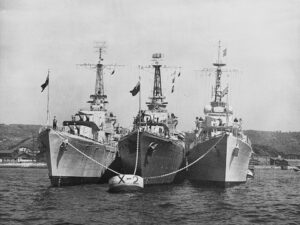 HMCS Nootka was laid down at Halifax on 20 May 1942, launched on 26 April 1944 and completed and commissioned on 9 August 1946. Photo: The Commonwealth tribals side by side in Korea, 1951: Warramunga, Nootka and COCKADE. Sje acted as TS for the Atlantic Fleet and took part in Operation Scuttled, exercise designed to sink U-190, but they were “stolen” the kill by an aircraft of the Naval Air Arm. By September 1948, she joined HMCS Magnificent and HMCS Haida on a training cruise to the Ungava Peninsula, Quebec. She stopped at Churchill, Manitoba (Hudson Bay) and was later converted from 15 August 1949. She sailed for the Korean War from 25 November 1950 via Panama Canal, relieved HMCS Sioux and on 25 January, was on shore bombardment duties, Inchon area and counter-fired by NK guns. She also screened aircraft carriers when not in inshore patrols. On 16 March she replaced Cayuga as the Senior Officer’s Ship for the Canadian force. In April 1951 she was in west coast blockade patrol. On 13–14 May she captured two junks, five sampans, retrieved 28 prisoners. In May she was sent for east coast bombardment and CV escort, before sailing back home on 20 July.
HMCS Nootka was laid down at Halifax on 20 May 1942, launched on 26 April 1944 and completed and commissioned on 9 August 1946. Photo: The Commonwealth tribals side by side in Korea, 1951: Warramunga, Nootka and COCKADE. Sje acted as TS for the Atlantic Fleet and took part in Operation Scuttled, exercise designed to sink U-190, but they were “stolen” the kill by an aircraft of the Naval Air Arm. By September 1948, she joined HMCS Magnificent and HMCS Haida on a training cruise to the Ungava Peninsula, Quebec. She stopped at Churchill, Manitoba (Hudson Bay) and was later converted from 15 August 1949. She sailed for the Korean War from 25 November 1950 via Panama Canal, relieved HMCS Sioux and on 25 January, was on shore bombardment duties, Inchon area and counter-fired by NK guns. She also screened aircraft carriers when not in inshore patrols. On 16 March she replaced Cayuga as the Senior Officer’s Ship for the Canadian force. In April 1951 she was in west coast blockade patrol. On 13–14 May she captured two junks, five sampans, retrieved 28 prisoners. In May she was sent for east coast bombardment and CV escort, before sailing back home on 20 July.
She departed on 12 February 1952 for a second tour until 9 February 1952: Island Campaign, west coast, islands around Chodo, Haeju region (March) and in 1952, Nootka off the west coast in general. On 26 September, she sank a North Korean minelaying junk. She sailed for home on 17 December 1952 via Panama, making a round trip. She had a refit modernization on 1953–1954 and resumed training for the Atlantic Fleet. In January 1958 she collided with HMCS Algonquin in the 1st Canadian Escort Squadron. She was present for the Cuban Missile Crisis in 1962, patrolling the northern tip of Cuba. In summer 1963, she made a tour of the Great Lakes with Haida and last deployment (NATO exercise) in Bermuda, fall 1963, taking hull damage while docking in strong winds. She was decommissioned at Halifax on 6 February 1964, stricken sold, scrapped at Faslane in 1965.
 HMCS Cayuga (1945)
HMCS Cayuga (1945)
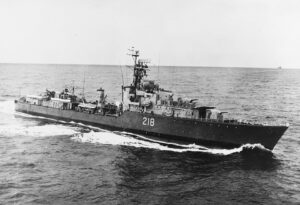 HMCS Cayuga was laid down on 7 October 1943, but much delayed and launched the last on 28 July 1945 and also the last commissioned on 20 October 1947 with the pennant R04. On 4 February 1948 she was transferred to the west coast, Esquimalt Naval Based in British Columbia. In October 1948 she joined the cruiser Ontario, DDs Athabaskan, Crescent and frigate Antigonish to Pearl Harbor, largest Canadian deployment postwar. In March 1950 with Ontario and Sioux she had a training cruise to Mexico, with port visits.
HMCS Cayuga was laid down on 7 October 1943, but much delayed and launched the last on 28 July 1945 and also the last commissioned on 20 October 1947 with the pennant R04. On 4 February 1948 she was transferred to the west coast, Esquimalt Naval Based in British Columbia. In October 1948 she joined the cruiser Ontario, DDs Athabaskan, Crescent and frigate Antigonish to Pearl Harbor, largest Canadian deployment postwar. In March 1950 with Ontario and Sioux she had a training cruise to Mexico, with port visits.
Next was the Korea: She made three tours in the war, last in 1954. From the first dispatch, departing Esquimalt on 5 July 1950. In 1952 she was refitted as a destroyer escort, DDE 218. For details about Korea, see the careers above. She became postwar a training ship on the west coast and on 1 January 1955, assigned to the 2nd Canadian Escort Squadron (Cdr Henry H. Davidson). In November 1955, she took part in one of the largest naval exercise off California. In January 1959 she was retransferred to the east coast, at Halifax. She was a TS until paid off on 27 February 1964, stricken, sold and BU at Faslane in 1965. She had a very preculiar badge and the native Cayugan motto “Onenh owa den dya” (“Now let us proceed”).
 HMCS Athabaskan (II) (1945)
HMCS Athabaskan (II) (1945)
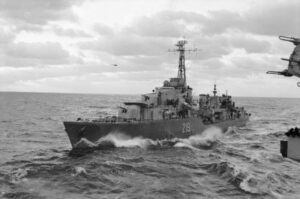 HMCS Athabaskan was named in 1944 after the loss of her earlier sister, first of the name, on 15 May 1944. She was launched at Halifax NyD on 4 May 1945 and commissioned on 12 January 1947. Assigned to the west coast as training ship until the Korean War. 1949 mutiny: On 26 February while on a fueling stop at Manzanillo in Mexico, 90 seamen locked themselves in their messdecks and refused to come out until the captain came to hear their grievances, notably over a lack of rum rations. There were similar incidents on HMCS Crescent in China, and HMCS Magnificent in the Caribbean. The Captains expertly defused these crisis.
HMCS Athabaskan was named in 1944 after the loss of her earlier sister, first of the name, on 15 May 1944. She was launched at Halifax NyD on 4 May 1945 and commissioned on 12 January 1947. Assigned to the west coast as training ship until the Korean War. 1949 mutiny: On 26 February while on a fueling stop at Manzanillo in Mexico, 90 seamen locked themselves in their messdecks and refused to come out until the captain came to hear their grievances, notably over a lack of rum rations. There were similar incidents on HMCS Crescent in China, and HMCS Magnificent in the Caribbean. The Captains expertly defused these crisis.
She made three tours of duty in the Korean War (see above for details of operations), from Esquimalt on 5 July 1950, back on 11 December 1953. With UN forces she patrolled the DMZ and made ASW patrols (with Soviet subs in the area), was in ship escorts and assisted in capturing ports ot transporta and evacuate troops and civilians and troops, after naval bombardments. She earned the battle honour “Korea 1950–53”.
Postwar she was in major refit, recommissioned on 25 October 1954 as DDE, and on 1 January 1955, joined the 2nd Canadian Escort Squadron, Pacific Command. She rescued the 16-year-old female stowaway Joan Pilapil on 7 August 1955. By November she took part in one of the largest naval exercises since WW2 off California. In January 1959 she was reassigned to the east coast, Tribal-class squadron, but battered by a major storm in NATO training that winter, and further damaged in collision with HMCS Bonaventure in 1963. For her final mission she rescued the crew of a Liberian tanker, Amphialos, which sank 40 km off of Liverpool. In reserve in 1964 at Halifax she was paid off on 21 April 1966, stricken and sold in 1969, scrapped in 1970 at La Spezia.
Read More/Src
Books
Brice, Martin H. (1971). The Tribals. London: Ian Allan.
Unlucky Lady: The Life and Death of HMCS Athabaskan 1940–44, Len Burrow & Emile Beudoin, Canada’s Wings, 1983
Campbell, N. J. M. (1980). “Great Britain”. In Chesneau, Roger (ed.). Conway’s All the World’s Fighting Ships 1922–1946. Mayflower Books.
Cooper, A (2010). HMAS Bataan, 1952: An Australian Warship in the Korean War. Sydney, Australia: University of NSW Press.
English, John (2001). Afridi to Nizam: British Fleet Destroyers 1937–43. Gravesend, UK: World Ship Society.
Friedman, Norman (2006). British Destroyers and Frigates, the Second World War and After. NIP
HMCS Haida: Battle Ensign Flying, Barry M. Gough, Vanwell, 2001
Hodges, Peter (1971). Tribal Class Destroyers: Royal Navy and Commonwealth. London: Almark Publishing.
Hodges, Peter; Friedman, Norman (1979). Destroyer Weapons of World War 2. Greenwich: Conway Maritime Press.
Lenton, H. T. (1998). British & Empire Warships of the Second World War. Annapolis, Maryland: Naval Institute Press.
Rohwer, Jürgen (2005). Chronology of the War at Sea 1939–1945: The Naval History of World War Two (Third Revised ed.) NIP
Whitley, M. J. (1988). Destroyers of World War Two: An International Encyclopedia. NIP
Links
navypedia.org/ tribal.htm
en.wikipedia.org Tribal-class_destroyer
coatneyhistory.com Tribal.htm
parks.canada.ca/ haida
web.archive.org hnsa.org/ Canadian tribals plans sets
on commons.wikimedia.org
rmg.co.uk/collections tribal plans
navyhistory.au/ australian tribal plans 1953
on tynebuiltships.co.uk/
on laststandonzombieisland.com/
on uboat.net/
maritime.org/doc/plans/tribal.pdf
naval-history.net/ Tribal-Afridi.htm
https://parks.canada.ca/lhn-nhs/on/haida
https://web.archive.org/web/20071014043515/http://hnsa.org/ships/haida.htm
https://commons.wikimedia.org/wiki/HMCS_Haida
Video
See also the 3h video by Dr.Alex
Model Kits
on scalemates.com/ Ex Trumpeter 1:350, 1:700, Airfix 1:1200, Pit-Road 1:700n HMAS Warramunga D123 Tribal Class Destroyer 1955 APS Models 1:72. And parts 1:350.

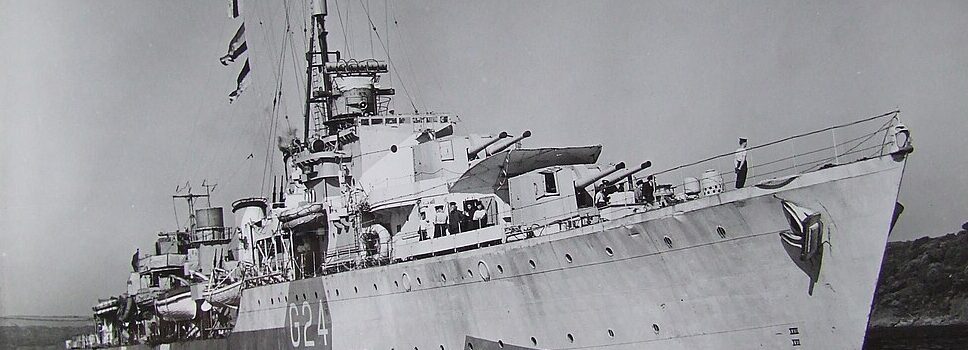




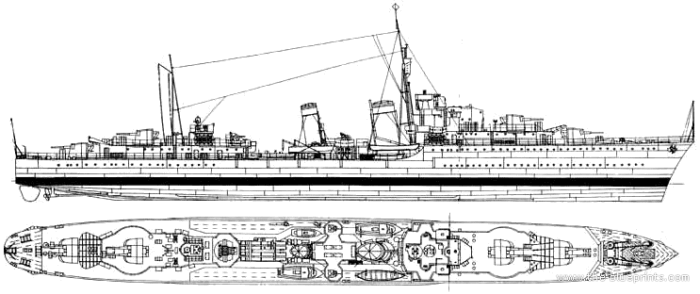
 Latest Facebook Entry -
Latest Facebook Entry -  X(Tweeter) Naval Encyclopedia's deck archive
X(Tweeter) Naval Encyclopedia's deck archive Instagram (@navalencyc)
Instagram (@navalencyc)





 French Navy
French Navy Royal Navy
Royal Navy Russian Navy
Russian Navy Armada Espanola
Armada Espanola Austrian Navy
Austrian Navy K.u.K. Kriegsmarine
K.u.K. Kriegsmarine Dansk Marine
Dansk Marine Nautiko Hellenon
Nautiko Hellenon Koninklije Marine 1870
Koninklije Marine 1870 Marinha do Brasil
Marinha do Brasil Osmanlı Donanması
Osmanlı Donanması Marina Do Peru
Marina Do Peru Marinha do Portugal
Marinha do Portugal Regia Marina 1870
Regia Marina 1870 Nihhon Kaigun 1870
Nihhon Kaigun 1870 Preußische Marine 1870
Preußische Marine 1870 Russkiy Flot 1870
Russkiy Flot 1870 Svenska marinen
Svenska marinen Søværnet
Søværnet Union Navy
Union Navy Confederate Navy
Confederate Navy Armada de Argentina
Armada de Argentina Imperial Chinese Navy
Imperial Chinese Navy Marinha do Portugal
Marinha do Portugal Mexico
Mexico Kaiserliche Marine
Kaiserliche Marine 1898 US Navy
1898 US Navy Sovietskiy Flot
Sovietskiy Flot Royal Canadian Navy
Royal Canadian Navy Royal Australian Navy
Royal Australian Navy RNZN Fleet
RNZN Fleet Chinese Navy 1937
Chinese Navy 1937 Kriegsmarine
Kriegsmarine Chilean Navy
Chilean Navy Danish Navy
Danish Navy Finnish Navy
Finnish Navy Hellenic Navy
Hellenic Navy Polish Navy
Polish Navy Romanian Navy
Romanian Navy Turkish Navy
Turkish Navy Royal Yugoslav Navy
Royal Yugoslav Navy Royal Thai Navy
Royal Thai Navy Minor Navies
Minor Navies Albania
Albania Austria
Austria Belgium
Belgium Columbia
Columbia Costa Rica
Costa Rica Cuba
Cuba Czechoslovakia
Czechoslovakia Dominican Republic
Dominican Republic Haiti
Haiti Hungary
Hungary Honduras
Honduras Estonia
Estonia Iceland
Iceland Eire
Eire Equador
Equador Iran
Iran Iraq
Iraq Latvia
Latvia Liberia
Liberia Lithuania
Lithuania Mandchukuo
Mandchukuo Morocco
Morocco Nicaragua
Nicaragua Persia
Persia San Salvador
San Salvador Sarawak
Sarawak Uruguay
Uruguay Venezuela
Venezuela Zanzibar
Zanzibar Warsaw Pact Navies
Warsaw Pact Navies Bulgaria
Bulgaria Hungary
Hungary

 Bundesmarine
Bundesmarine Dutch Navy
Dutch Navy Hellenic Navy
Hellenic Navy Marina Militare
Marina Militare Yugoslav Navy
Yugoslav Navy Chinese Navy
Chinese Navy Indian Navy
Indian Navy Indonesian Navy
Indonesian Navy JMSDF
JMSDF North Korean Navy
North Korean Navy Pakistani Navy
Pakistani Navy Philippines Navy
Philippines Navy ROKN
ROKN Rep. of Singapore Navy
Rep. of Singapore Navy Taiwanese Navy
Taiwanese Navy IDF Navy
IDF Navy Saudi Navy
Saudi Navy Royal New Zealand Navy
Royal New Zealand Navy Egyptian Navy
Egyptian Navy South African Navy
South African Navy






























 Ukrainian Navy
Ukrainian Navy dbodesign
dbodesign